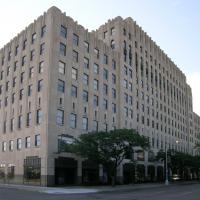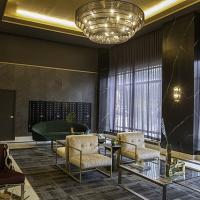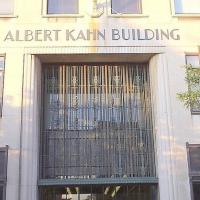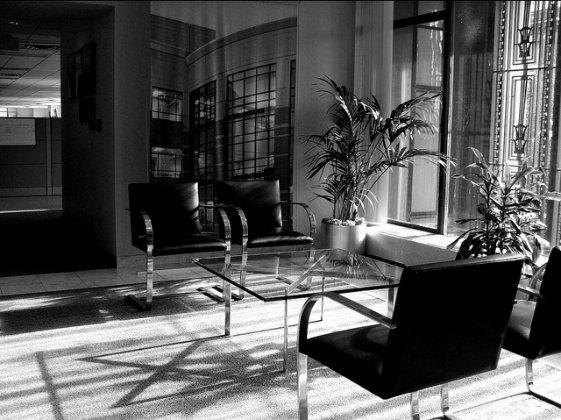-
Entry author
-
Yihan Wang
-
Abstract
-
The Albert Kahn Building, funded by the Fischer brothers during the Great Depression, was designed by renowned architect Albert Kahn and is attached to the Fisher and General Motors Buildings as an office building. Its construction not only provided jobs for workers but also helped to stimulate the local economy.
Although it's a commercial building, based on the period of time it was built and the comparison with other commercial buildings in the Fisher family, the Alber Kahn building can be seen as a gift the Fisher family gave back to society during the recession. The Fisher brothers often used their wealth to better the city and its people. They gave millions to charities, civic causes, churches, educational institutions and to making Detroit one of the finest cities in the world (historicdetroit.org, 2011).
-
https://detroithistorical.org/blog/2021-11-16-fisher-family-story
-
https://www.usatoday.com/story/money/cars/2015/03/05/fisher-building/24419849/
-
Address
-
7430 2nd Ave, Detroit, MI 48202
-
Architect
-
Albert Kahn
-
Date (comission)
-
1930
-
Date (completion)
-
1931
-
Program/ function
-
office building/retail
-
Contractor
-
Albert Kahn Associates Inc
-
Date (modification, adaptation, renovation)
-
October 18,1988; the new center was renamed after its architect and longtime tenant, Albert Kahn.
2001, the Albert Kahn Building and the Fisher Building were sold to the south field-based Farbman Group for $31 million
2015. Farbman lost both the Kahn and Fisher buildings in foreclosure, and they were auctioned for $12.2 million, along with a parking garage and a parking lot, to a group led by The Platform
June 4, 2018, it was announced that the Kahn Building was sold to Birmingham, Mich.-based Lutz Real Estate Investments and Farmington Hills, Mich.-based Northern Equities Group, which plan to convert the building from office space to 200 apartments. The first residents are expected to start moving in in mid-2019.
Mid 2021, the Albert Kahn Building in Detroit's New Center has entered a new phase of life and reopened as upscale housing.
-
https://historicdetroit.org/buildings/albert-kahn-building
-
https://www.partneresi.com/our-work/multi-scope-due-diligence-albert-kahn-building-detroit-mi
-
Style/ distinct features/ cultural reference
-
Art Deco
An anchor of the New Center business district, the Albert Kahn Building offers a rich history behind its Art Deco facade. From its industrialist patrons and world famous architect, to the many prominent businesses that have occupied its floors, the edifice encapsulates the era that vaulted Detroit into international prominence(Detroit Free Press, 5 Aug. 2021).
-
Beneficiaries and impact on the community
-
Built in the early 1930s during a period of recession in Detroit, the Albert Kahn building played a crucial role in providing employment opportunities for many local workers.
As the city's infrastructure stalled and many were left jobless, the construction of this building created a much-needed boost to the local economy. Upon its completion in 1931, the Albert Kahn building became the centerpiece of the city's commercial district, attracting foreign businesses to invest in Detroit and spurring economic development. This, in turn, provided more job opportunities for local residents, further contributing to the city's growth and prosperity.
-
Was it part of a network of buildings?
-
Albert Kahn Building, The Fisher, and Henry Ford Hospital were all joined together by a series of underground passageways lined with shops. They were all funded by the Fisher family. These tunnels were used for the convenience of employees, and are still open today, though many storefronts are not in use.
-
Sustainability (financial, cultural)
-
The economic contribution of the Albert Kahn Building was enormous. His Building attracted many companies and businesses during the Detroit Depression, which helped to slow the city's economic decline.
-
Size/ scale
-
114,139 SF
-
Q1: What were the motivations of the gift-giver and the implications of the gift for the community ?
-
As fisher brother said "We feel that by taking this course it will serve as an incentive to others to proceed with normal expansion and thus assist in solving the unemployment problem. We want further to give a practical demonstration of our continued and steadily growing faith in the future of Detroit."
The construction of the Albert Kahn Building was a demonstration of the Fisher family's continued and steady confidence in Detroit's future. The Great Depression brought big construction projects to a near standstill. In the early 1930s, the workload of many construction workers was greatly reduced. To demonstrate their commitment to Detroit and its people, the Fisher family accelerated plans for the Albert Kahn Building. The Fisher brothers hope the building will create more jobs and continue to support the city's new central business district. And the building was very effective in attracting a lot of commercial activity. By 1966, the new central business district was still thriving, although the nearby buildings and activities were disappearing
-
Q2: Was there an imposed sense of responsibility or reciprocation in the case study, and who were the parties that were charged with these actions?
-
The Albert Kahn Building, one of the buildings the Fisher family donated in Detroit, is not just a step in the Fisher family's expansion of its business, as opposed to the commercial value and prestige of its investments. Albert Kahn building is more like a charity building.
The Fisher family did not receive any direct financial benefit from the Albert Kahn Building, for the Fisher family, the Albert Kahn Building was more of a social reward and responsibility than an investment. The building represents the Fisher family's commitment to Detroit Society. As an office building attached to the Fisher Building, it was built to help Detroit survive economically.
The Fisher brothers intended the New Center Building to be the first in a series of similar structures that would continue to buoy the growth of the New Center business district. Though these additions never realized, New Center remained highly successful and prestigious through the first half of the 20th century. As Midtown and parts of downtown Detroit began to flag in the 1950s, New Center remained dynamic. In large measure, this survival hinged on the presence of the General Motors headquarters (historicdetroit.org, 2011).
-
http://www.time.com/time/magazine/article/0%2C9171%2C764715%2C00.html
-
Q3: Do the design characteristics (i.e material, layout, location) reflect either the culture of the giver, the culture of the receiver, or a mixture of both?
-
Detroit's popularity among 20th-century Art Deco buildings owes much to its status as a thriving industrial center. Art Deco architecture, with its bold geometric shapes, clean lines, and emphasis on modern materials, was a perfect fit for Detroit's industrial and technological identity. The style was also seen as a way to revitalize the city's image after the economic struggles of the Great Depression.
"In the 1930s, during the Great Depression, Art Deco became more subdued." Although the architecture of the Albert Kahn building continues the Art Deco style of the Fisher Building, they represent different meanings because they were built at different times, the Fisher Building, built at the height of Detroit's economic boom, represents the Fisher family and a symbol of the city's economic success.
But the Alber Kahn building was built in the 1930s, just as the world economy was in recession, so the building was built to provide employment and an incentive for Detroit workers. And it continues the Art Deco style
-
https://en.wikipedia.org/wiki/Art_Deco
-
Bibliography
-
McDonald, Blake. “Albert Kahn Building: Historic Detroit.” Albert Kahn Building -. HistoricDetroit.org, 2011.
https://historicdetroit.org/buildings/albert-kahn-building
Reindl, J. C. “Detroit’s Historic Albert Kahn Building Transformed into Upscale Apartments: Look Inside.” Detroit Free Press, 5 Aug. 2021, www.freep.com/story/money/business/2021/07/29/new-center-detroit-albert-kahn-apartments/5374214001/. Accessed 26 Apr. 2023.
Fogelman, Randall (2004). Detroit's New Center. Arcadia Publishing. pp. 54
https://historicdetroit.org/buildings/albert-kahn-building.
"RETAILING: Department Stores Chained". Time. 16 September 1940. Archived from the original on October 14, 2010. Retrieved 2011-05-24.
 Bob Julius, Albert Kahn Building 2010, JVLIVS Photography, April 9, 2010, 1,088 × 612, image/jpeg
Bob Julius, Albert Kahn Building 2010, JVLIVS Photography, April 9, 2010, 1,088 × 612, image/jpeg Duggan, Kahn Building (2021) A.jpg,The Kahn Bldg ribbon cutting,October 6, 2021,5,316 × 3,544,image/jpeg
Duggan, Kahn Building (2021) A.jpg,The Kahn Bldg ribbon cutting,October 6, 2021,5,316 × 3,544,image/jpeg Anthony Lockhart,Albert Kahn Building front.jpg,2007, 639 × 417 ,image/jpeg,https://www.flickr.com/photos/71288712@N00/877347238/in/photolist-2kwCLw-74xmy9-81PZzt-bvNiYo
Anthony Lockhart,Albert Kahn Building front.jpg,2007, 639 × 417 ,image/jpeg,https://www.flickr.com/photos/71288712@N00/877347238/in/photolist-2kwCLw-74xmy9-81PZzt-bvNiYo Jake Lyon,Albert_Kahn_Associates_office.jpg (561 × 420 pixels, file size: 62 KB, MIME type: image/jpeg),2004,https://www.flickr.com/photos/54177923@N05/5064731545/in/photolist-8Hy5eF-nmDW5F
Jake Lyon,Albert_Kahn_Associates_office.jpg (561 × 420 pixels, file size: 62 KB, MIME type: image/jpeg),2004,https://www.flickr.com/photos/54177923@N05/5064731545/in/photolist-8Hy5eF-nmDW5F Helmut Ziewers,Front entrance lobby view, (www.ziewersphotography.com), HistoricDetroit.org,https://historicdetroit.org/galleries/albert-kahn-building-photos
Helmut Ziewers,Front entrance lobby view, (www.ziewersphotography.com), HistoricDetroit.org,https://historicdetroit.org/galleries/albert-kahn-building-photos



